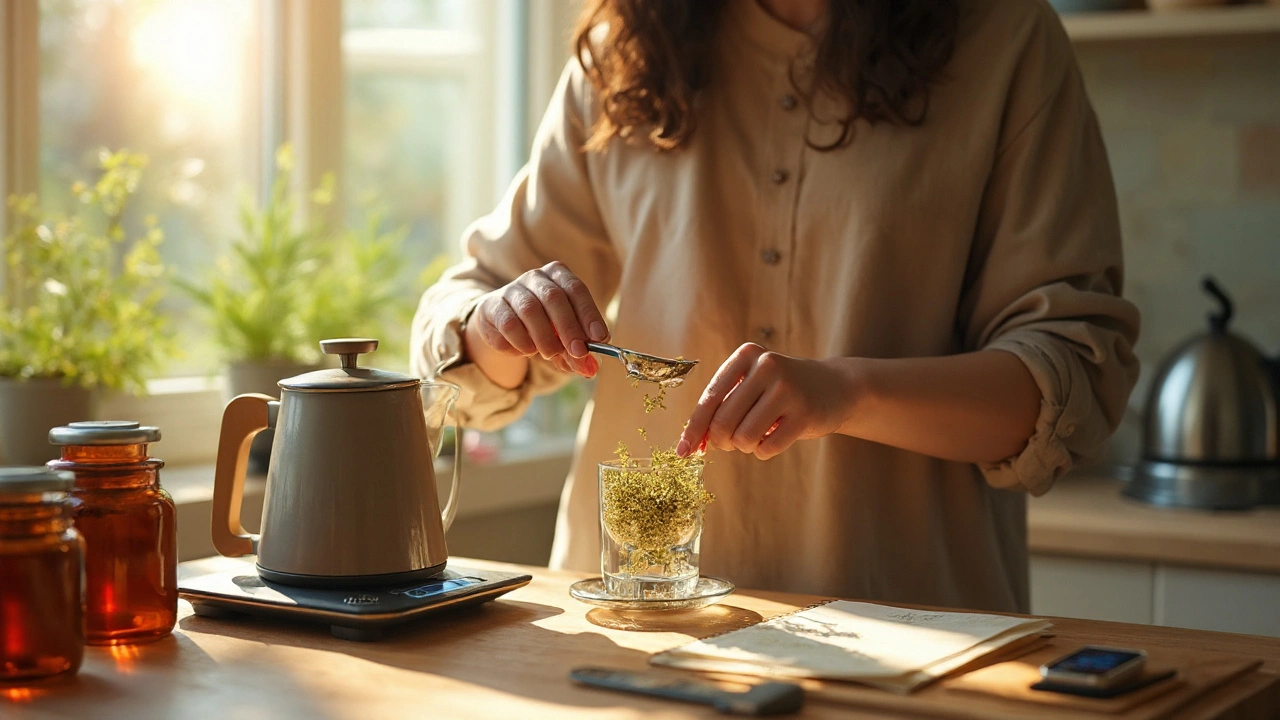Lady’s Bedstraw Supplement: Benefits, Uses, Safety, and How to Start (2025 Guide)
 Aug, 31 2025
Aug, 31 2025
You want a natural supplement that actually moves the needle-less puffiness, calmer skin, better urinary comfort, more lightness in your day-without sketchy side effects. Lady’s bedstraw (Galium verum) keeps popping up in wellness circles as that quiet helper. Here’s the honest take: it’s not a miracle, but it can be a gentle, useful part of a routine for fluid balance and skin/lymph support if you use it right and buy a clean product.
TL;DR
- What it is: A traditional European herb used for mild diuretic, lymph, and skin support; evidence is mostly historical and lab-based, with limited human trials.
- Who it helps: People dealing with mild water retention, puffy mornings, or looking for a gentle nudge for urinary comfort-assuming no medical red flags.
- How to use: Tea, tincture, or capsules; start low, hydrate well, and give it 1-3 weeks. Stack with nettle or dandelion only if you tolerate diuretics.
- Safety: Avoid in pregnancy/breastfeeding, kidney disease, on strong diuretics, or with bleeding disorders. Stop if you feel dizzy, overly thirsty, or crampy.
- Buy smart: Look for the Latin name (Galium verum), plant part, third‑party testing (USP, NSF, BSCG), and clean labels with no sketchy fillers.
What Lady’s Bedstraw Is-and What It Can Realistically Do
Lady’s bedstraw (Galium verum) is a flowering plant in the coffee family (Rubiaceae). Historically, people stuffed mattresses with it (hence “bedstraw”), colored cheese with its yellow dye, and used it in teas for swelling and skin issues. It’s not the same as “cleavers” (Galium aparine), but they’re botanical cousins and get used for similar goals.
What people reach for it for today:
- Mild water retention and puffiness, especially around the eyes or late in the day
- A gentle nudge for urinary comfort (not a UTI cure)
- Skin clarity support through indirect lymph/urinary pathways
- A soft “reset” after salty meals or travel
What’s in it: iridoid glycosides (such as asperuloside-like compounds seen across Galium species), flavonoids (e.g., quercetin and kaempferol derivatives), phenolic acids, and tannins. This mix lines up with traditional uses: diuretic/aquaretic effects (more urine output), astringency (toning tissues), and antioxidant support.
What the science says, in plain English:
- Lab and animal work on Galium species points to mild diuretic and antioxidant actions. Human clinical trials on Galium verum specifically are scarce to none as of 2025.
- More research attention has gone to relatives like cleavers (G. aparine) for “lymphatic” support and to better-studied diuretics like nettle leaf (Urtica dioica) and goldenrod (Solidago virgaurea).
- So, use Lady’s bedstraw as a gentle aid, not as a primary treatment for medical conditions.
Credible references to guide expectations: traditional European herbal texts and pharmacopeias note diuretic and skin-toning uses for Galium species; modern reviews in journals like Journal of Ethnopharmacology summarize in vitro/animal data; clinical guidance for urinary infections from the Infectious Diseases Society of America stresses medical evaluation for UTIs. The NIH Office of Dietary Supplements outlines general supplement safety best practices.
Bottom line on lady's bedstraw benefits: expect subtle, cumulative wins-less ankle/face puffiness, a feeling of being “lighter,” sometimes calmer skin. If you need fast or dramatic results, this isn’t that herb.

How to Use Lady’s Bedstraw Safely and Effectively
You’ve got three practical options: tea, tincture, or capsules. Tea gives you a gentle, hydrating approach. Tinctures let you dose precisely. Capsules are convenient when you’re busy or traveling.
Practical starting doses (for healthy adults):
- Tea (dried aerial parts): 1-2 teaspoons (about 2-4 g) per 250 ml hot water, steep 10-15 minutes, 1-2 times daily.
- Tincture (1:5 in 40% alcohol, or per label): 2-4 ml up to 3 times daily. Start lower if you’re sensitive.
- Capsules: 500-1,000 mg once or twice daily, per a reputable brand’s label. Start at the low end for a week.
When to take it: morning and early afternoon are ideal. If you take it late, you may wake to pee. If you’re using it for travel-related puffiness, take a dose after you land and again the next morning.
Hydration and electrolytes: diuretics move water out. Match each dose with a glass of water and a pinch of electrolytes or a mineral-rich food (e.g., a banana, broth, or coconut water). If you feel thirsty, lightheaded, or crampy, you’ve either overdosed or under-hydrated-pull back.
Smart stacks (optional):
- Nettle leaf (Urtica dioica): gentle mineral-rich diuretic; stack for a short, 7-14 day “de-puff” window.
- Dandelion leaf (Taraxacum officinale): potassium-sparing diuretic; helpful if salty-food swelling is your main issue.
- Goldenrod (Solidago virgaurea): urinary comfort herb; often used seasonally.
Don’t stack more than two diuretic-type herbs at once unless you’re experienced, and stop if you feel off. If you’re on prescription diuretics, skip stacks and talk to your clinician.
Simple tea recipe:
- Add 1-2 tsp dried Lady’s bedstraw to a mug.
- Cover with 250 ml hot water. Steep 10-15 minutes.
- Strain, sip warm. Optional: lemon slice or a bit of honey.
- Drink with a glass of plain water on the side.
A 7‑day reset plan (for healthy adults):
- Days 1-2: Tea once daily, morning. Track how often you pee and how you feel.
- Days 3-5: Increase to twice daily if you felt fine. Add a mineral-rich snack.
- Days 6-7: Keep twice daily or drop back if your sleep gets disrupted. Notice rings fitting looser, less facial puffiness, or steadier energy.
When to pause or stop:
- You feel dizzy, weak, overly thirsty, or have muscle cramps.
- Your urine turns very dark or you pee far less despite drinking (seek care).
- You start a new prescription that affects kidneys, fluids, or blood pressure.
Who should avoid or get medical advice first:
- Pregnant or breastfeeding people (safety data lacking).
- Anyone with kidney disease, a history of kidney stones that are actively symptomatic, heart failure, or serious blood pressure issues.
- On medications that are diuretics, lithium, or blood thinners. Galium species contain coumarin-like constituents; the bleeding-risk interaction is theoretical but worth caution.
- Allergies to Rubiaceae plants (rare but possible).
How long until you notice something: some people notice less puffiness within 24-48 hours; most need 1-2 weeks. Skin clarity and “lighter” energy often track to the second week. If nothing changes in three weeks, it may not be your herb.
What not to expect: fat loss. Peeing more is not losing fat. You’re shifting water balance. Use it to support comfort, not as a weight-loss fix.
| Form | Typical Dose | When It Fits | Approx. 2025 Price (USD) | Pros | Cons |
|---|---|---|---|---|---|
| Tea (loose herb) | 2-4 g per 250 ml, 1-2x/day | Daily gentle support; hydration focus | $10-$18 per 50-100 g | Hydrating, adjustable strength, budget-friendly | Taste matters; prep time; variable potency |
| Tincture (1:5 or per label) | 2-4 ml up to 3x/day | Precise dosing; travel | $14-$28 per 30-60 ml | Fast to use; consistent dosing | Alcohol base; stronger taste |
| Capsules | 500-1,000 mg 1-2x/day | Convenience; no taste | $12-$26 per 60-120 caps | Portable; no prep | Less flexible dosing; check fillers |
Simple self-checks to avoid pitfalls:
- If you’re peeing every 30-45 minutes, dose is probably too high.
- If you wake more than once nightly to pee, move your last dose earlier or reduce it.
- If your hands feel dry and you get calf cramps, add electrolytes and reduce dose.
- If your face is still puffy after a week, review salt intake and sleep; the herb can’t beat lifestyle.

How to Choose a Quality Product-and Decide If It’s Right for You
Not all “bedstraw” products are the same. Labels sometimes mix up species, plant parts, or add cheap fillers. Here’s how to shop like a pro.
Quality checklist (keep this handy):
- Latin name: must say Galium verum, not just “bedstraw.”
- Plant part: aerial parts (herb) are standard for teas/tinctures.
- Origin and processing: organic or clean wildcrafted; low-temperature drying is a plus.
- Extraction details: for tinctures, look for the ratio (e.g., 1:5) and solvent (e.g., 40% alcohol).
- Third‑party testing: USP, NSF, BSCG, or ConsumerLab verification for purity and label accuracy.
- Clean label: minimal excipients; no artificial colors; allergen disclosure.
- Lot number and expiry date: freshness matters with aromatic herbs.
Red flags:
- “Proprietary blend” with no amounts listed.
- Vague “bedstraw complex” without species.
- Grand promises like “melts fat” or “cures UTIs.”
Decision guide: is Lady’s bedstraw a good fit today?
- You want mild help with water retention, your blood pressure is stable, and you’re not on diuretics → reasonable to try.
- You’re struggling with recurrent UTIs, fever, pain, or blood in urine → stop reading and see a clinician. UTIs need diagnosis and may need antibiotics per IDSA guidelines.
- You’re training hard in heat or on keto and already losing fluids → either avoid or use very cautiously with electrolytes.
- You’re pregnant, breastfeeding, or have a kidney/heart condition → skip unless your clinician okays it.
How it compares to close alternatives:
- Cleavers (Galium aparine): similar “lymph” tradition; slightly more attention in modern herb texts; taste is greener, stickier. Pick if lymph focus is your priority.
- Nettle leaf (Urtica dioica): mineral-rich diuretic; often better for seasonal puffiness with fatigue. Pick if you want diuretic support plus minerals.
- Dandelion leaf (Taraxacum officinale): potassium-sparing diuretic; good for post-salty-meal puffiness. Pick if you cramp easily and need potassium.
- Goldenrod (Solidago virgaurea): urinary comfort; widely used in Europe. Pick if your main goal is bladder comfort after activity.
Best for / Not for:
- Best for: healthy adults who retain fluid mildly, want a gentle herbal nudge, and are willing to hydrate and track how they feel.
- Not for: anyone wanting rapid weight loss, people with complex fluid-balance issues, or folks seeking a stand-alone fix for medical problems.
Mini‑FAQ
Can I take Lady’s bedstraw every day?
Yes for short stretches (1-3 weeks) if you feel good and labs/health are normal. Many people cycle it: 2-3 weeks on, 1-2 weeks off.
Is it safe in pregnancy or breastfeeding?
There’s not enough safety data. Most clinicians advise avoiding it during pregnancy and lactation.
Will it help me lose weight?
It can reduce water weight, not fat. If the scale drops overnight, that’s water. Sustainable fat loss needs diet, movement, sleep, and stress support.
Can it prevent or treat UTIs?
No. It may support hydration and comfort, but UTIs require proper diagnosis and timely treatment. Seek care if you have burning, urgent peeing, fever, flank pain, or blood in urine.
How fast does it work?
For puffiness, sometimes within 1-2 days. For skin and a general “lighter” feel, expect 1-2 weeks.
Any interactions?
Be cautious with prescription diuretics, lithium, and anticoagulants. Space it from meds by 2-3 hours to avoid absorption issues from tannins.
Tea vs tincture vs capsules-which is best?
Tea if you like rituals and hydration; tincture for precision; capsules for convenience. Potency depends on product quality, not just form.
Next steps and troubleshooting
- If you’re new: start with tea once daily for a week. Journal sleep, bathroom trips, energy, and swelling.
- If you get night peeing: move last dose to before 3 p.m. or reduce dose by half.
- If you feel crampy: add electrolytes and cut dose by 25-50%.
- If nothing happens by week two: consider nettle or dandelion leaf instead, or check sodium intake and sleep.
- If you liked it but want a maintenance plan: 5 days on, 2 off; or every other day. Keep water steady.
- If you’re managing a medical condition or multiple meds: bring the product label to your clinician or pharmacist before starting.
About evidence and credibility
Here’s the evidence stance as of September 2025: clinical trials specific to Galium verum are limited; support comes from traditional European use, phytochemical profiles, and lab/animal data across Galium species. For guidance on urinary issues, clinicians rely on professional bodies such as the Infectious Diseases Society of America. For supplement safety and quality, the NIH Office of Dietary Supplements and independent verifiers like USP, NSF, BSCG, and ConsumerLab provide frameworks and testing standards. Use this herb as a supportive measure within a bigger wellness picture-hydration, minerals, sleep, movement, and sensible salt intake still do the heavy lifting.
Victor T. Johnson
September 18, 2025 AT 13:16Craig Ballantyne
September 20, 2025 AT 12:03Sakthi s
September 21, 2025 AT 23:27Nicholas Swiontek
September 22, 2025 AT 09:34vanessa parapar
September 24, 2025 AT 07:02Julia Jakob
September 25, 2025 AT 17:10Ben Wood
September 26, 2025 AT 05:29Abhi Yadav
September 27, 2025 AT 07:46Shannon Wright
September 28, 2025 AT 15:28Rachel Nimmons
September 30, 2025 AT 15:21Robert Altmannshofer
October 1, 2025 AT 15:56Kathleen Koopman
October 1, 2025 AT 20:01Nancy M
October 2, 2025 AT 00:12Robert Asel
October 2, 2025 AT 12:57